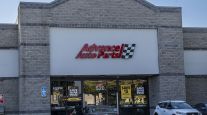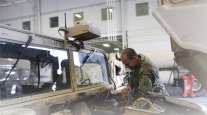Contributing Writer
VMRS Portal Is Nearly Here
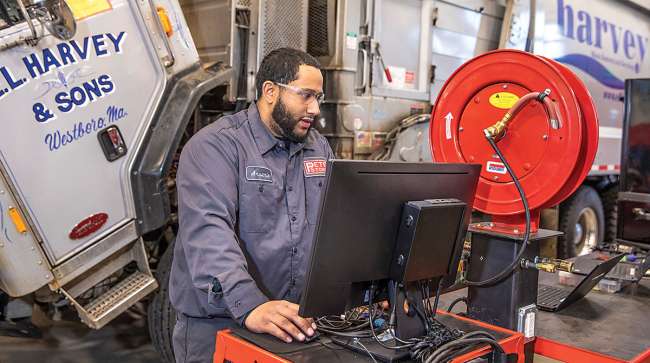
[Find the latest in equipment & maintenance: Explore this quarter's issue of Calibrate]
Created in the 1970s, the Vehicle Maintenance Reporting Standards system is a continuously updated, universal coding convention for parts, equipment and labor. It’s used by fleets, manufacturers, suppliers and others. Fleets can use the data for budgeting, purchasing and tracking expenses. American Trucking Associations’ Technology & Maintenance Council has been responsible for VMRS since 1997. Now, the system is undergoing major updates, including an online portal, codes for electric vehicles, and, potentially, codes for maintenance operations and alerts.
VMRS is divided into 65 code keys providing homes for data. In Code Key 33, the component code, nine-digit numbers describe equipment down to the specific part. One upcoming change, a portal, is nearly ready to roll out. It will provide licensees live access to updates and files so that they won’t have to contact TMC staff or wait for updates to be sent via spreadsheet. A few licensees are beta-testing the system now.
Jack Poster, TMC’s VMRS services manager, hopes to make a major announcement at TMC’s annual meeting in New Orleans in March. “At that point, it will be, ‘We’re up and running. It’s ready to go. If you have a license, get on board,’ ” he said.
Poster said creating the portal has been a challenge. In Code Key 33, there were 35,336 nine-digit codes as of Dec. 18.
More Q1 Calibrate
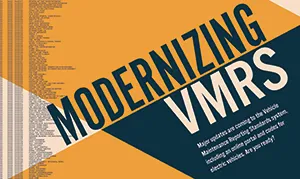
►VMRS Portal Is Nearly Here
►Freeze: Our Electric Future: You Don't Have to See It to Believe It
►Five Questions: Craig Provonsha
►Industry Needs Agreement on Future of Trailer Connections
►Baxter: Driver Support Is Key to Electric Powertrain Adoption
Explore the Issue!
Meanwhile, TMC members and others are voting on changes to TMC’s recommended practices that would create a coding convention for maintenance labor alerts and repair priorities under Code Key 25. Balloting will continue until Feb. 9.
The alerts would notify licensees of recommended future maintenance tasks performed at specific intervals. Six characters would designate a maintenance labor alert. The first three would use an existing system code denoting the system where the task would be performed, while the second three would represent the task itself.
Another addition would be three new codes in Code Key 16, the repair priority class. Prompts such as “due soon,” “past due” and “request performed” would join the current codes of “scheduled,” “non-scheduled” and “emergency.” As an example, 044-A03-04 would be “engine fuel system, fuel filter replacement, due soon.” After the work is done, that operation would be coded with the same first six numbers and then “06,” or “request performed,” replacing the “04.”
The idea was the brainchild of Brian Mulshine, Navistar’s director of digital service delivery. He said activities like changing an oil filter can involve multiple parts and steps. A code is needed for the overall maintenance activity so fleets, manufacturers, independent shops and others can all be aware of what was done using a common language.
“A maintenance operation is a set of operations, not just a part,” he said.
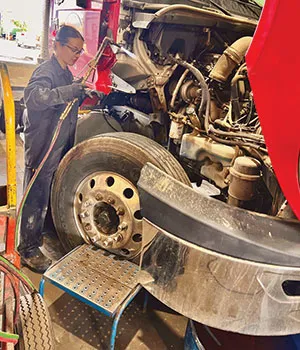
Camille Ouimet is an apprentice at International Rive-Nord in Quebec. (Navistar via LinkedIn)
Mulshine estimated that 220 to 230 codes are needed to cover every maintenance event for all internal combustion engine-powered vehicles from Class 8 to medium.
He added VMRS should evolve to keep pace with predictive maintenance and “remaining useful life” activities that are becoming increasingly common in the trucking industry. He said maintenance intervals like oil changes will be based on sensor-driven information supplied by the truck rather than set mileages; for example, a truck hauling steel has different maintenance needs than one hauling pillows. A common language, Mulshine contended, is needed among industry partners to describe those RUL-based operations.
“That’s where the industry’s going to be going in the future, but you cannot do this in the future with large fleets unless you have a way to handshake each other,” he said.
Mulshine explained such a system would reduce the number of staff members that fleets now need to hand-code activities. It also would help with translation issues when American fleets work with fleets that employ large numbers of French-Canadian and Spanish-speaking workers.
As of early January, Mulshine said the response to the changes has been good. Upon enough support, members will read the ballot discovery and comments, make adjustments and approve it at TMC’s fall meeting.

Poster
Poster said he hasn’t heard negative comments.
“The thing about VMRS is if you don’t want to use that part of it, you don’t have to,” he said. “There’s no set rule that says you have to use this certain code key.”
Arkansas-based Maverick USA has been using VMRS since the mid-1990s. Kyle Mitchell, regional service manager, said staff are often on the phone with Poster and often articulate concerns and challenges in TMC’s VMRS subcommittee meetings. Maverick USA ranks No. 79 on the Transport Topics Top 100 list of the largest for-hire carriers in North America.
Mike Jeffress, the fleet’s vice president of maintenance, noted how Maverick uses the technology as a way for the maintenance staff to explain issues — for example, two units’ tire costs trending higher than usual — to other departments.
Jeffress added that as technology rapidly changes and the industry increasingly integrates artificial intelligence, VMRS will have to keep up, he said, and TMC has done a good job of keeping up with technology changes so far.
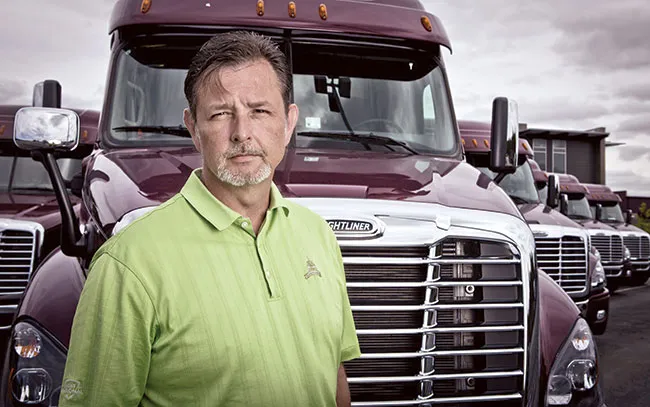
Maverick's Jeffress noted that VMRS will have to keeppace with innovations like artificial intelligence. (Maverick USA)
“ATA’s got to be a hundred percent committed to keeping this going, keeping it viable, or we’ll lose it through this data integration, futuristic, AI,” he said. “We’ve got to figure out how is AI going to be used to nail this down and truly drive the productivity up.”
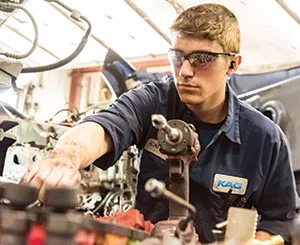
Training helps avoid misclassifications. (Kenan Advantage Group)
Also, the incorporation of electric vehicle parts into VMRS continues to grow. As of January, there were 452 codes in Code Key 33. The component codes have “electric vehicle” at the end of the description. Poster, who’s been with TMC for 17 years, said the council is being judicious as it vets the codes because it prefers not to tweak codes after release.
“It’s the most difficult challenge because everything is so new,” he added.
VMRS is constantly evolving. Years ago, Poster received an email saying there was no code for masking tape. Once he confirmed that was true, he created a new code. In 2021 TMC launched updated licenses, new codes, a new subscription fee system based on a company’s sales revenues, and an updated, 900-page handbook. TMC also worked with Decisiv to provide members a quarterly report about industrywide maintenance trends based on VMRS work order data.
“One thing about VMRS in total: It’s basically like a living organism,” he said. “We’re always adding new codes. The codes never rest.”

Altrichter
Poster said the VMRS system can be daunting. Fleet personnel should do their due diligence and have a VMRS liaison with TMC. He encourages users to audit their operations and the information they are receiving.
Kirk Altrichter, executive vice president of fleet services for Kenan Advantage Group, said fleet personnel are diligent in making correct entries, and training helps avoid misclassifications. “You’ve got to stay after it,” he said. “The devil’s in the details, and you’ve got to make certain that you’re watching for erroneous entries. … As with anything, you’ve heard the expression, ‘Garbage in, garbage out,’ so you’ve got to make certain that you’ve got a filter on the front end so the garbage doesn’t get in.”

Maverick uses VMRS as a way for the maintenance staff to explain issues to other departments. (Maverick USA)
Kenan Advantage, which ranks No. 22 on the for-hire TT100, uses VMRS in all repair orders for parts and labor. It helps the carrier understand costs by component and is particularly helpful with warranties, including those that might have been missed.
Likewise, VMRS makes everyone’s jobs more efficient and helps TransAm Trucking better track expenses, said Rick Silvers, parts manager.
“We have ours to where there’s one report that’s generated for me every month, and through it, I can see which areas have gone up and come down, then begin to make my analysis based on that,” he explained. “If I need to drill deeper, then I do.”
At Southeastern Freight Lines, parts shelving is organized by VMRS code across all 27 of the company’s shops, said Kelly Fitzgerald, fleet services purchasing manager. That creates consistency and commonality across the company. The fleet ranks No. 32 on the for-hire TT100.
“I’m a fan of it,” she said. “I like organization ... being able to walk in any shop and communicate in the same language.”

Coffman
Kristy Coffman, director of the commercial vehicle group for Mitchell 1, a maintenance information provider, said VMRS is becoming more popular because of the complexity of vehicles and the system’s ease of use.
“It’s like a great secret that people are finally learning to embrace,” she said. “It was a philosophy and an implementation that was probably before its time, and when you are dealing with so many different entities, yet we’re all trying to get to a common goal. Getting to have a common language is imperative.”
Want more news? Listen to today's daily briefing below or go here for more info:


